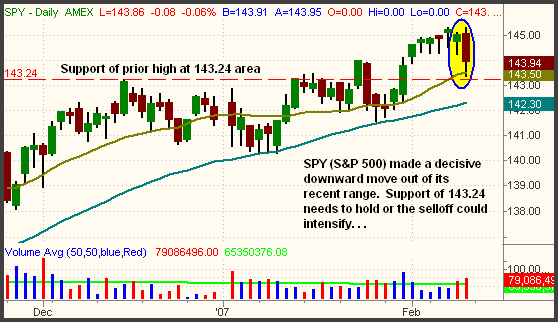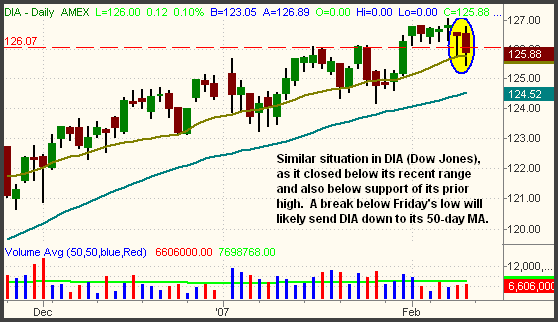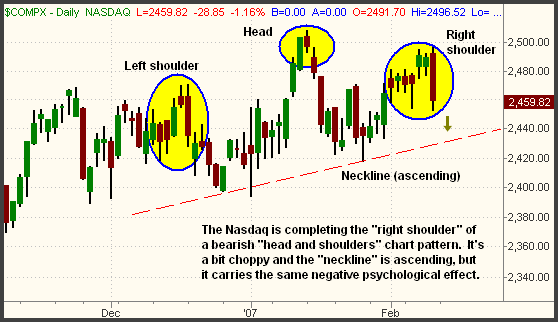|
The Wagner Daily ETF Report for February 12
After a full week of being stuck in a tight, sideways range, the S&P 500 finally made a decisive, higher volume move last Friday. Unfortunately for the bulls, its break out of the trading range was a 0.7% selloff to the downside. The Dow Jones Industrial Average fared slightly better with its 0.5% loss, but weakness in the technology sectors caused the Nasdaq Composite to slide 1.2%. The small-cap Russell 2000 similarly fell 1.1%, while the S&P Midcap 400 declined 0.7%.
Total volume in the Nasdaq increased by 10%, while volume in the NYSE was 3% higher than the previous day's level. The significant losses on higher volume caused both the S&P and Nasdaq to register a bearish "distribution day" that was indicative of institutional selling. It was the third "distribution day" within the past four weeks. When the market posts four or more days of higher volume selling within a four-week period, it becomes a confirmed sign of institutional distribution, as opposed to a healthy correction. Since institutions are responsible for more than half of the market's average daily volume, a market can not sustain a rally without the support of buying from mutual funds, hedge funds, pension funds, and other institutional activity. Firmly negative market internals confirmed the bearishness. In both exchanges, declining volume exceeded advancing volume by a margin of nearly 3 to 1.
Last Thursday, both the S&P 500 and Dow Jones Industrial Average "undercut" their one-week trading ranges, meaning they probed below support on an intraday basis, but recovered to close the day within their prior bands of consolidation. When this type of action occurs, it is usually bullish because stops get hit and overhead supply dries up. Often, the stock or index will break out above the trading range to a new high the following day. However, it is quite bearish if the next day's session results in a closing price at or below the prior day's intraday low instead. Such is what occurred last Friday. This is illustrated on the daily charts of both the S&P 500 SPDR (SPY) and Dow Jones DIAMONDS (DIA) below:


Unlike the S&P and Dow, the Nasdaq Composite showed relative strength by not undercutting during Thursday's session, but Friday's session was very damaging for the tech-heavy index. After only two days of trading above pivotal resistance of the 2,470 level, the Nasdaq slid back down into its three-month, sideways range. Furthermore, the Nasdaq is now in the process of completing the "right shoulder" of a bearish "head and shoulders" chart pattern. Though the formation of the pattern has been choppy, the parts of the "head and shoulder" are labeled on the daily chart below:

The inability of the Nasdaq to hold above the 2,470 level, combined with Friday's negative action, increases the odds that the index will test support of its "neckline" within the next several days. If the Nasdaq breaks below that level, it will confirm the follow-through of the "head and shoulders" pattern. If that occurs, the projected drop below the "neckline" is equal to the distance from the top of the "head" down to the "neckline." That equates to a projected downward move of about 90 points, around the 2,328 area. For easy reference, this corresponds the area of support around the November 2006 lows.
Due to an indecisive market, we still have only two open positions: long StreetTRACKS Gold Trust (GLD) and long UltraShort QQQ ProShares (QID). GLD is still acting well, as it closed the week at its highest level in eight months. Our target remains just over the $69 area. A rogue trade 20 cents below the best bid caused us to stop out of QID right after the open, but we promptly sent an intraday e-mail alert to subscribers, informing them we were re-entering the position because the trade appeared to be a specialist "stop hunt" below support. Obviously, we're pleased about the judgment call to re-enter the position, as the Nasdaq 100 Index sold off sharply and the inversely correlated QID rallied sharply. The Nasdaq 100 Index has a similar "head and shoulders" pattern as the Nasdaq Composite, and already closed back below its 50-day MA. We have raised our stop in the QID position to the same price as our re-entry, thereby removing all risk from the trade. Because it is not directly correlated to the equities market, we are still targeting the CurrencyShares Euro Trust (FXE) for potential long entry, but it has not yet triggered.
Deron Wagner is the Founder and Head Trader of both Morpheus Capital LP, a U.S. hedge fund, and Morpheus Trading Group, a trader education firm launched in 2001 that provides daily technical analysis of the leading ETFs and stocks. For a free trial to the full version of The Wagner Daily or to learn about Wagner's other services, visit MorpheusTrading.com or send an e-mail to deron@morpheustrading.com.
|